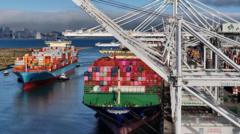U.S. President Donald Trump has rolled out extensive tariffs impacting over 90 countries, a move designed to enhance American manufacturing and confront perceived unfair global trading practices. Just before the August 7 deadline for trade negotiations, Trump claimed via his Truth Social platform that substantial revenue was already entering the U.S. through these import taxes.
The administration's strategy targets job creation domestically and aims to diminish the trade deficit, which underscores the gap between U.S. imports and exports. Trump's tariffs impose additional taxes on goods purchased by U.S. importers from foreign nations, often resulting in higher prices for consumers as importers may transfer some of these costs to customers.
The average U.S. tariff rate is now at a historic high, with various specific levies affecting industries like vehicles and steel. The freshly established tariffs, announced in April but previously paused amid market reactions, created a diverse landscape of rates across different countries. Export-heavy Southeast Asian nations are expected to feel significant impacts, particularly Laos and Myanmar, which face levies reaching 40%.
Markets in Asia reacted positively on the day of implementation, with most major indexes showing slight increases despite the ongoing uncertainty. This development provides some much-needed stability following months of potential trade disruptions. Notably, countries including the UK, Japan, and South Korea have struck agreements to secure lower tariff rates on exports to the U.S.
However, other economies, like Switzerland, are grappling with steep tariffs — in their case, 39% on goods. Taiwan has been assigned a 20% rate, which its president described as provisional while discussions with the U.S. are still open. In a more recent move aimed at exerting pressure on India, Trump announced plans to increase tariffs on imports from the country to 50% unless it stops purchasing oil from Russia, denouncing such transactions as "unjustified."
Furthermore, in a bid to influence tech investment, Trump declared a potential 100% tariff on foreign-made semiconductors. This move coincided with Apple's commitment to invest $100 billion in the U.S., encouraged by the administration's pressure to reshift more production to domestic grounds.
While some countries navigate through unilateral tariff adjustments, there’s a looming concern over the potential for escalated trade tensions, especially amid ongoing geopolitical shifts related to Russia. The complexity of these tariffs reflects Trump's broader agenda as he seeks to renegotiate the parameters of international trade, which remains a crucial point of focus in his presidency.


















